Macao Noise Pollution Assessment and Control
| 論文類型 | 基礎研究 | 發表日期 | 2005-10-01 |
| 來源 | Macau Environment and City Development 2002 | ||
| 作者 | Tam,Vai,Man,Zhishi,W | ||
| 關鍵詞 | noise acoustics noise pollution noise prediction noise monitoring | ||
| 摘要 | Through statistically analyzing data obtained from noise survey and regular monitoring, the acoustic environment in Macao peninsular is profiled. Traffic noise is the most important source of noise and its relation to environmental noise is qualitatively | ||
Macau Environment and City Development 2002
MACAO NOISE POLLUTION ASSESSMENT AND CONTROL
Tam Vai Man* Zhishi Wang
Faculty of Science and Technology, University of Macau
Abstract: Through statistically analyzing data obtained from noise survey and regular monitoring, the acoustic environment in Macao peninsular is profiled. Traffic noise is the most important source of noise and its relation to environmental noise is qualitatively depicted. The result of using STAMSON (a computer model) to simulate environmental noise is quite satisfying. The average errors between simulation results and monitoring data are less than 2dB. Moreover, a brief but comparably comprehensive questionnaire was conducted to collect public response to noise exposure, especially on annoyance.
Key words: noise, acoustics, noise pollution, noise prediction, noise monitoring
1. INTRODUCTION
It has been demonstrated that community noise has direct adverse effects on human beings. They include adverse effects on communication, performance, behavior, noise-induced disturbance of sleep, community annoyance and so on. In Europe, almost 25% of the population is exposed to transportation noise over 65 dB(A) (24h Leq). When one realizes that at 65dBA sound pressure level, sleeping becomes seriously disturbed and most people become annoyed, it is clear that community noise is a genuine environmental health problem.
As a city that has a total area of 23.8 Km2 and a population of about 450 000, the acoustical environment in Macao is even more unsatisfying. The significant increase in the number of complaints over the past years show that, on one hand, there is a growing public dissatisfaction on noise problem in the community, on the other hand, the existing controls on environmental noise have not gone far enough to meet community expectations.
2. MACAO PENINSULAR NOISE SURVEY 2000
2.1. Noise Survey Procedures
A square mesh grid map (300mx300m /cell) of Macao peninsular is used for selecting the noise monitoring sites. The measuring sites are chosen in the center or near to the cell center. In addition, some sites are selected near to the Macao region center in the cells. These sites are anticipated to show typical daytime and nighttime noise levels at specific locations by short duration grab sampling. The daytime and nighttime samples were collected by 15 minutes of continuous monitoring.
2.2. Data Analysis
2.2.1. Daytime Leq 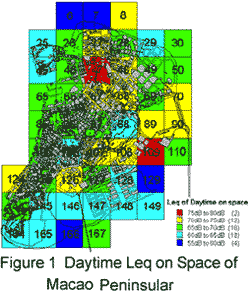
The daytime average Leq is 66.5dB(A) in Macao peninsular. Compare this figure to the P.R.C. National Standard of Environmental Noise of Urban Area, the noise environment in Macao is unmatched to all types of residential area. It only coincides with the roadside environmental noise limit of 70dB(A), which is the worst situation allowed in the standard.
The range of daytime Leq is from 55.3dB(A) to 77.8dB(A) and the variation is 22.5 dB(A). It reveals that noise environment in Macao peninsular varies a lot in different areas. As Figure1 shows, there are 14 cells whose daytime Leq values are more than 70dB(A). This indicates that about 30% of the Macao peninsular area is under an unfavorable noise environment.
No.47 and No.109 are the noisiest zones during daytime because they are close to the very busy roads in Macao. Besides cell No.47 and 109, there are 12 cells whose noise environment at
daytime is also not acceptable because they attain noise level over 70dB(A).
On the other hand, there are 18 cells whose daytime Leq values are not satisfactory even they matched with the P.R.C. National Standard. If the noise environment does not improve in the future, these 18 cells will become noisier and not suitable for residential use anymore. In these 18 cells, though traffic noise is the major noise source, both commercial as well as industrial noise are subjects that could not be neglected.
2.2.2. Nighttime Leq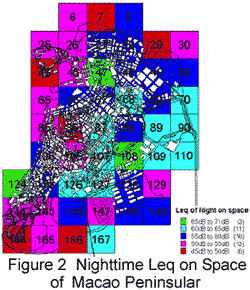
In the P.R.C. National Standard of Environmental Noise of Urban Area, roadside noise limit at nighttime is 55dB(A). However, the nighttime average Leq in Macao peninsular is 57.0dB(A), and it is 2dB(A) above the standard limit. This illustrates that the overall nighttime noise environment is very unsatisfactory in Macao peninsular. On the other hand, there are 30 cells whose nighttime Leq values are above 55dB(A). It is the other evidence indicating that more than 60% of area at nighttime in Macao is very noisy.
The range of Leq at nighttime is from 47.2dB(A) to 70.3dB(A), and the variation shows that the noise environment varies a lot in different usage of the cells. No.47 is still the noisiest zone of all. Again, the traffic noise is blamed for causing the high level of noise. The noise environment of nighttime is shown in Figure 2.
2.2.3. Daytime L95
L95 is used to represent the background noise level of a region. The average daytime L95 value is 58.2dB(A). This value is barely acceptable because it is around 60dB(A) that is considered as noisy situation in many western countries.
As Figure 3 shows, 16 cells are categorized in the group of 49-50dB(A) that means about 1/3 of the Macao peninsular area are under an acceptable noise environment. Except No.87 and No.106, the others are low residential density areas. A total of 30 cells whose daytime L95 is less than 60dB(A). This indicates that the noise environment in some 62% of Macao peninsular area is moderate, in spite of that fact that less than 40% of the population lives in those areas.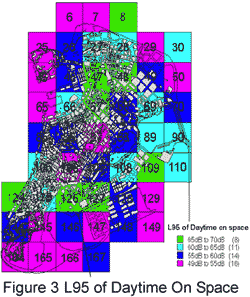
If the evaluation criterion changes to the legitimate reference of daytime background noise level - 65dB(A), the percentage will add up to 84%. That means most area in Macao is under this kind of noise environment. On the other hand, there are 8 cells whose daytime L95 levels are higher than 65dB(A). The major cause of high background noise level is the busy traffic flow, except No.8 and No.109 to which commercial activities are the other important noise sources.
Although the background noise situation is not satisfactory, there has not strict relation between background noise level and public nuisance. However, high background noise level can have bad effect on human health which should raise public concerns.
2.2.4. Daytime Difference Between Leq and L95
The difference between Leq and L95 represents the variation between environmental and background noise level. The greater the difference is, the more severe is the noise fluctuation and disturbances.
The average difference between daytime Leq and L95 is 8.4dB(A) that is slightly lower than the 10dB(A) legitimate limit. From this point of view, the legal standard may have some disadvantages in practical use because the actual noise environment almost exceeds it.
As Figure 4 shows, there are 17 cells or 35% of Macao peninsular area whose Leq and L95 difference are greater than 10dB(A). Even if traffic noise is always considered as liner noise source, its real characteristic is impulsive while the automobiles just come by the sound level meter in a short period of time. Moreover, since industrial noise and commercial noise are comparably steadier than traffic noise. A difference of 10dB(A) or more is an evident that traffic noise is the major environmental noise source.
23 cells are in the second category. As the traffic volume is larger in these places, the amplitude of noise level fluctuation is less intense. Furthermore, 9 cells are categorized in the last group, 0dB(A) to 5dB(A). That means the noise environment is more stable in these regions. There are two possible explanations: (1) the traffic volume is so large that it diminishes the impulsive effect; (2) the traffic volume is not large enough to stir up noise fluctuation.
2.2.5. Nighttime L95
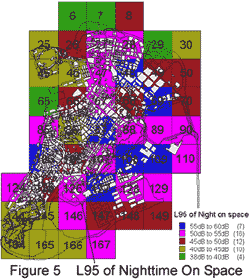 The legitimate reference of nighttime background noise level is 55dB(A). While using this criterion to evaluate the survey data, the outcome is satisfactory because only 7 cells exceed its standard and nearly 86% of the Macao peninsular area fulfills it. However, the average is 48.6dB(A) and is about 6dB(A) less than the reference. What is more, there are 26 cells whose nighttime background noise level is less than 50dB(A), and these cells cover about 53% of Macao area. So in practical use, the reference may be inadequate. (Figure 5)
The legitimate reference of nighttime background noise level is 55dB(A). While using this criterion to evaluate the survey data, the outcome is satisfactory because only 7 cells exceed its standard and nearly 86% of the Macao peninsular area fulfills it. However, the average is 48.6dB(A) and is about 6dB(A) less than the reference. What is more, there are 26 cells whose nighttime background noise level is less than 50dB(A), and these cells cover about 53% of Macao area. So in practical use, the reference may be inadequate. (Figure 5)
2.2.6. Nighttime Difference Between Leq and L95
The average difference between nighttime Leq and L95 is 8.4dB(A) and is close to legitimate limit. The disadvantages of the legal standard may still exist at nighttime and even 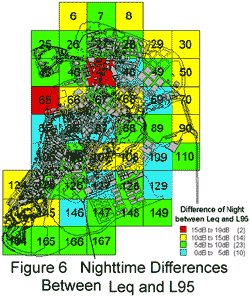 subjectively more apparent because of the quiet environment at night.
subjectively more apparent because of the quiet environment at night.
As Figure 6 shows, No.47 and 65 are the two regions whose Leq and L95 differences exceed 15dB(A). When the difference exceeds 15dB(A), especially at nighttime, it may cause sleep disturbance. There are 16 cells whose Leq and L95 difference are greater than 10dB(A). This should raise enough concerns to prevent further deteriorating of the noise environment.
2.2.7. Noise Level Differences Associate with Cell Function
In order to evaluate the data more comprehensible and thoroughly, the data were re-classified by different functions of each cell.
As Figure 7 and Figure 8 show, park is the quietest type of all the functions both at day and  nighttime. Traffic and industrial combination is the noisiest. Similarly, traffic and commercial is the second noisiest combination. If we use the P.R.C. standard of roadside noise level as criterion, visibly, these two types can fulfill the standard neither at day nor nighttime. Besides these two types, the combination of traffic, industrial, commercial and residential noise also goes beyond the standard.
nighttime. Traffic and industrial combination is the noisiest. Similarly, traffic and commercial is the second noisiest combination. If we use the P.R.C. standard of roadside noise level as criterion, visibly, these two types can fulfill the standard neither at day nor nighttime. Besides these two types, the combination of traffic, industrial, commercial and residential noise also goes beyond the standard.
These data prove that traffic is the main noise source in Macao peninsular. Moreover, industrial and commercial noise sources are also important factors that affect the community‘s noise environment.
3. Regular Environmental Noise Monitoring
As the acoustical environment deteriorated with the city development, it is essential to set up a regular  monitoring program to understand the noise environment in Macao. For this reason, in 1997, 12 stations of regular monitoring were set up in Macao peninsular. These 12 stations were selected according to different land use. In 1999, in order to profound the knowledge of
monitoring program to understand the noise environment in Macao. For this reason, in 1997, 12 stations of regular monitoring were set up in Macao peninsular. These 12 stations were selected according to different land use. In 1999, in order to profound the knowledge of
acoustic situation of Macao peninsular, another 8 stations were added into the regular environmental noise monitoring. These 20 stations cover most area of Macao peninsular.
3.1. Data AnalysisOverall Noise Situation
Only the data of 1999 and 2000 are selected to evaluate the overall noise situation in Macao peninsular. Figure 9 shows the average daytime noise situation at those 20 stations. The horizontal blue line represents P.R.C. noise standard for daytime roadside noise limit, and the red line is the legitimate reference background noise level in Macao peninsular.
3.1.1. Leq
The average equivalent noise level of 20 stations is 71.4dB(A) and slightly exceeds the P.R.C. roadside limit. Only 4 stations‘ Leq values are less than 70dB because they are located at places where has less traffic noise.
On the other hand, the equivalent noise level of 3 stations (No.11, 8 and 7) is 5dB(A) higher than the P.R.C. stand. Obviously, these stations represent the noisiest area in Macao peninsular. Though these 3 stations are located in different region of Macao, they are all set on the busy roadside. The traffic volume of Station 11 is around 4000 vehicles per hour, while Station 8 and 7 are around 3000 veh/hr. Clearly, the environmental noise levels of these stations are closely related to the traffic volume. The larger the traffic flow is, the higher the noise level is. Besides the close relationship between the quantity of traffic and noise level, vehicle types also play an important role in environmental noise. This can be seen that the heavy-duty vehicles produce much higher level of noise than light duty vehicles. Station 11 is the noisiest, not only because of the very high traffic volume, but also because of having more than 800 heavy-duty vehicles per hour.
3.1.2. L95
The L95 value of a station is also influence by the types and intensity of human activities. Industrial regions, commercial centers or large traffic volume areas are likely to have higher background noise level. Station 11, 8, 7, 15 and 5 are the examples for large traffic volume while station 1 is the example for industrial region.
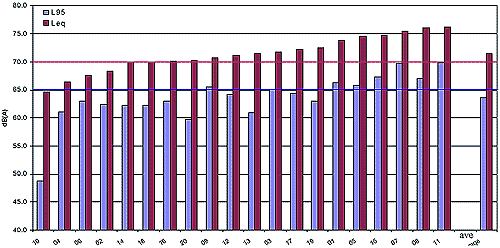
Figure 9 Daytime Leq and L95 of 20 Regular Monitoring Stations
3.2. Yearly Variations of Noise environment
Figure 10 shows the year average Leq data of 12 stations from 1997 to 2000. The 1998 data was special. Generally, the Leq data dropped in 1999. This result happened to match with the economic recession after the financial crisis in 1998. Station 10 appeared to be the most 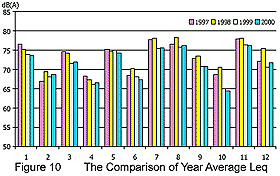 sensitive area to economic change. After the crisis, tourists from Hong Kong, Japan, Taiwan and other countries declined a lot. Fewer visitors mean less tourist buses. Because tourist buses are the major noise source of site 10, the Leq fell with decrease of buses. (Figure 11)
sensitive area to economic change. After the crisis, tourists from Hong Kong, Japan, Taiwan and other countries declined a lot. Fewer visitors mean less tourist buses. Because tourist buses are the major noise source of site 10, the Leq fell with decrease of buses. (Figure 11)
However, the background noise environment has less conection with the economic situation. The background noise level of each site was comparably steady for all the monitoring years.
4. Traffic Noise Simulation
As traffic is the most important noise source in Macao peninsular, it deserves to conduct particular study and analysis on this issue. Every single vehicle that runs on the roads or streets does its contribution to the noise environment. Since each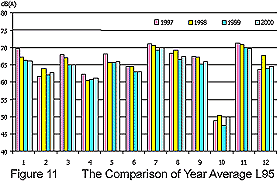 type of vehicles produce a relatively certain level of noise, using traffic volume as a key parameter to simulate traffic noise is commonly used worldwide. In this study, STAMSON, which is a model developed in Canada, was employed to simulate and to predict the traffic noise level in Macao peninsular after adjusting some parameters.
type of vehicles produce a relatively certain level of noise, using traffic volume as a key parameter to simulate traffic noise is commonly used worldwide. In this study, STAMSON, which is a model developed in Canada, was employed to simulate and to predict the traffic noise level in Macao peninsular after adjusting some parameters.
4.1. Current Environmental Noise Simulation
The amount and average speed of different types of vehicles are vital to traffic noise prediction. According to the actual traffic situation in Macao peninsular, Table 1 lists the referenced noise level of different types of vehicles.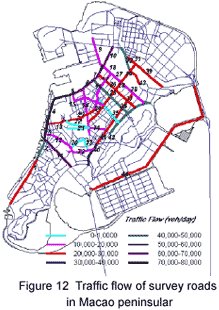
Table 1 Referenced Noise Level
original vehicle types AU MC BU LT MT HT noise level /dB 65.0 71.0 71.0 67.5 72.5 74.6 the ratio to AU 1.0 1.09 1.09 1.04 1.12 1.14 STAMSON category AU MT HT
Notes: AU-- automobile; LT-- light truck; MT-- medium truck;
HT-- heavy truck; MC-- motorcycles; BU--bus.
Figure12 shows that, the total traffic flows of Rua da Ribeira do Patane, Avenida do Almirante Lacerda and Avenida de Almeida Ribeiro are very busy, and these roads have comparatively high level of noise.
Not only does the traffic flow affect the noise level, but also the speed of vehicles does. In this research, according to the situation in Macao, the vehicular speed is divided into three parts: 0 to 20 km/hr, 20 to 40 km/hr, and over 40 km/hr. Since the vehicular speed on many roads do not exceed 40km/hr, 40km/hr is selected as the maximum speed while using STAMSON to do the simulation.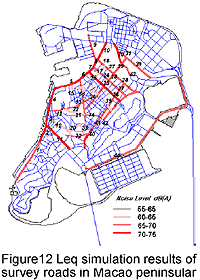
In addition, because many roads in Macao have some gradient, and because the gradient of a road has some effects on the running situation of a vehicle and the noise it produces, the gradient of each researched road has been investigated. For simplicity, and due to the less importance of this parameter, the gradient of each road is classified as 0 to 5 degree, 5 to 15 degree, and 15 to 30 degree.
Simulation Result
The noise generated by vehicles, either because of its level or because of its impact to the surroundings, is the most important noise source in modern cities. The intensity of traffic noise, while other factors are comparably unvarying, greatly depends on the traffic flow and the speed of vehicles, also gradient of the road has some effects as well.
The simulation results have to compare with the regular monitoring data to examine their accuracy. The regular monitoring data of year 1999 are used because the traffic flow survey was done in that year. However, since not all of the regular monitoring sites were covered in the area of traffic survey, only the data of 8 stations are compared.
For the site located at roadside, the simulation result is the same as that road. For that located at a corner of the cross of two roads, the simulation result is the addition of the results of these two roads. The simulation results are showed in Table 2.
Table 2 Comparison between simulation results and monitoring data
site No. 1 3 5* 7 8* 11* 12* 18* simulation
result
D1 73.4 70.2 74.8 74.4 74.6 75.7 70.3 70.6 D2 74.4 71.3 73.6 74.4 76.2 77.3 71.8 71.1 D3 72.7 69.6 74.5 73.7 74.0 75.3 69.9 71.8 D4 73.9 70.7 74.9 74.8 75.1 76.2 70.8 69.7 N1 71.1 67.5 73.4 72.0 71.3 73.5 66.7 68.0 N2 66.4 63.2 68.6 67.6 68.5 68.6 64.4 59.7 D-average 73.6 70.5 74.5 74.3 75.0 76.1 70.7 70.8 monitoring
data
D1 73.6 71.3 74.8 75.0 75.1 76.2 70.2 70.2 D2 74.3 71.3 74.8 75.1 75.7 76.5 70.1 69.4 D3 73.9 70.4 74.3 75.3 75.5 76.2 70.4 69.6 D4 73.9 72.1 75.1 75.6 75.6 76.4 70.8 70.4 N1 69.8 68.4 73.4 73.5 73.4 75.0 69.0 66.5 N2 63.2 62.6 58.6 68.0 68.8 67.8 63.2 62.5 D-average 73.9 71.3 74.8 75.3 75.5 76.3 70.4 69.9
* -- The site located at the corner of a cross.
It can be seen that the simulation results matched with the monitoring data. The average errors are less than 2dB and are in the permissive range. The daytime simulation results cope with monitoring data even better. The less accuracy of nighttime simulation may be due to less precision of the nighttime traffic situation, while the traffic survey was mainly done at  daytime.
daytime.
5. Public Opinions on Noise
Since the annoyance of noise is subjective, the same level of noise may have very different response in different areas and at different period of time. In environmental noise legislation, these differences should take into account for better protecting the public health and welfare from the deleterious effects of noise.
5.1. Overall impression
In Macao peninsular, 51% of all interviewees rated the noise environmental as acceptable and 11% thought Macao is a quiet city. Among them, 36% cited that Macao is noisy, and only 2% of them regarded it as very noisy. (Figure 13)
Though the day and nighttime noise levels are high comparing with many other cities, the majority of the interviewees (more than 60%) considered the noise environment in Macao as acceptable or quiet. This illustrated that many Macao residents accustomed the situation and did not feel it much disturbing. On the other hand, the similarity of noise environment at most places in Macao peninsular, and the evenness of the noise level may also be the reasons of this result.
5.2. Neighborhood noise environment
At daytime, 15% of all the interviewees classify their neighborhood as quiet, 57% as acceptable and 28% as noisy. The nighttime results are similar to daytime with 27% quiet, 50% acceptable and 23% noisy.
Comparing the data of overall impression to those of neighborhood, though they are associated to some extend, these people‘s impressions towards the noise environment of their neighborhood are better than that of Macao peninsular. Because many Macao residents lived in high-storey-buildings, the distance of their apartments from the ground degraded the strength of noise from the streets.
At nighttime, about 77% interviewees cited that their neighborhoods are quiet or acceptable, more than that of daytime (5%). More people consider their neighborhoods are quiet at nighttime because many of the daytime activities stopped, fewer vehicles running in the city, most people off duty.
5.3. Noise disturbance
63% of all the interviewees reported that noise disturbed their daily life, mostly sleep. Among the disturbed people, 40% of them claimed that it happened at daytime, 49% at nighttime, and 11% at both day and nighttime. These data revealed that the high level of noise has affected the living quality of many Macao residents.
5.4. Noise sources
At daytime, 66% of all the interviewees thought traffic noise are the major source of noise in their daily life. Commercial noise is the second significant noise source with a percentage of 26. Domestic noise generated by their neighbors is rated as 16%. Traffic noise is the most important noise source in Macao, and the noise from commercial activities and their neighbors are also important.
At nighttime, the percentage of traffic noise had a noticeable decrease from 66% to 52%. Much less vehicles running on the streets at nighttime may result the reduction. In addiction, the percentage of interviewees who claimed construction noise or industrial noise is the source of noise also dropped a lot because most construction works are prohibited and only a few factories are still operating at night.
On the contrast, the rate of interviewees who reported commercial noise and domestic noise increased at nighttime. Especially at early nighttime, when most residents are off duty, the prim time for restaurants and karaoke began. The noise generated by commercial activities became more significant. At this period of time, most people went back home, and the probability of producing noise escalated. At nighttime, traffic noise is still the major source and noise from commercial and domestic are other eminent sources.
6. Conclusion and Suggestion
* Restricted by the inadequate land area, most regions in Macao peninsular are for residential use, and at the same time commercial or industrial use embed in them. Moreover, since the network of land transportation covers Macao peninsular very densely, traffic use is inseparable from other kinds of land use. The traffic-industrial used region is the noisiest, while park is the quietest kind of land use.
* The average equivalent noise level of Macao peninsular is about 70dB(A). However, the places that are located beside the main drains of city transportation had the Leq exceeding 75dB(A). The average L95 is around 63dB(A) and is approximate to the legitimate reference 65dB(A). However, the legitimate reference had some restriction in actual application because the background noise level of Macao varied a lot. To consider public interest, the reference level should categorize for various land use.
* The noise environment in Macao peninsular is much affected by the traffic situation. Areas that have undesirable noise level also have very busy traffic flow. To control traffic noise, city planning, especially the planning of land transportation plays an important role. Moreover, to regulate the noise emission standard of different kinds of vehicles will also be effective to quiet the noise environment.
* Since the simulation results matched the monitoring data, using STAMSON to simulate or to predict the noise environment, especially the traffic noise level, is proper.
* 62% of all interviewees rated the noise environmental of Macao peninsular as acceptable or quiet. 63% of all the respondents reported of noise annoyance. Traffic noise is the most easily perceptible and the major source of noise at both day and nighttime. Commercial and domestic noise of the neighborhood is the other important sources of noise.
close
www.fun208.com相關推薦
- Micro-Polluted Surface Water Treatment by PAC-MBR Process
- NMR characterization of residual structure in the denatured state of protein L
- Daily Influent Quantity Forecasting Method for Sewage Treatm
- Leakage control in water supply systems and rehabilitation o
- Spatial Analysis of Vehicular Emission Pollution in Macau Pe
- Macao Noise Pollution Assessment and Control
論文搜索
月熱點論文
論文投稿
很多時候您的文章總是無緣變成鉛字。研究做到關鍵時,試驗有了起色時,是不是想和同行探討一下,工作中有了心得,您是不是很想與人分享,那么不要只是默默工作了,寫下來吧!投稿時,請以附件形式發至 paper@h2o-china.com ,請注明論文投稿。一旦采用,我們會為您增加100枚金幣。








